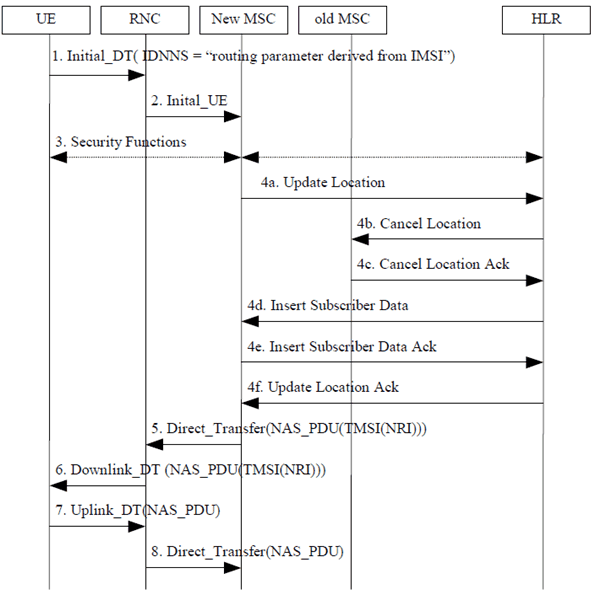Content for TS 23.236 Word version: 18.0.0
7.5 IMSI attach procedure / Location area update with IMSI p. 30
This signalling flow shows the basic IMSI attach or location update procedure when a UMTS UE registers to a pool-area by mobile identity type IMSI.

Step 1.
UE requests the setup of the RRC connection and sends the Initial_DT including the Intra Domain NAS Node Selector (IDNNS). The IDNNS indicates that the routing parameter is derived from IMSI.
Step 2.
The RNC selects the MSC as described in clause 7.1.3. The Initial-UE message is generated on RANAP and sent via Iu-CS to the selected MSC/VLR.
Step 3.
The optional security functions can be executed.
Step 4.
Since the UE wasn't registered in the MSC before the Map Update-location procedure to HLR is invoked by the MSC:
Step 5.
- The update-location is sent to HLR;
- In case the UE was registered in another VLR the HLR sends cancel location procedure to old VLR;
- The old VLR acknowledges with Cancel location Ack;
- The HLR sends insert-subscriber data to the new VLR;
- The new VLR acknowledges with insert-subscriber data Ack;
- After finishing the location update procedure the HLR responds with Update-location to the new VLR.
The MSC/VLR assigns a new TMSI to the UE and sends this TMSI value in the location-update accept to the UE. The TMSI contains the NRI of the VLR. The location update accept is carried in the NAS-PDU of the RANAP direct-transfer over Iu interface.
Step 6.
The RNC transparently forwards the NAS-PDU to the UE in the RRC downlink-DT message.
Step 7.
In the UE the new TMSI (including the NRI) and the LA are stored on SIM and the TMSI-reallocation complete is generated. This NAS message is returned to CN in the Uplink-DT via RRC. The mobile shall use this new TMSI next time it performs a mobile originating procedure.
Step 8.
The RNC forwards the NAS-PDU transparently to the MSC/VLR in the NAS-PDU of a Direct-transfer on Iu interface. If the TMSI-reallocation complete is received in the MSC/VLR the TMSI is considered as valid for the UE. From then on the UE will be addressed using this TMSI value.